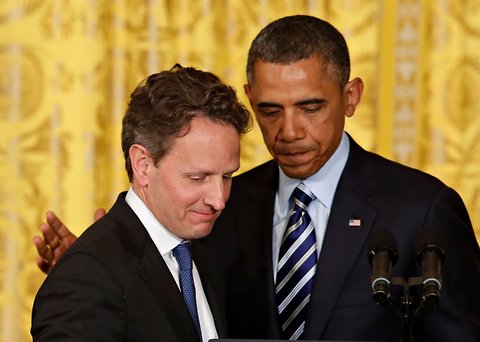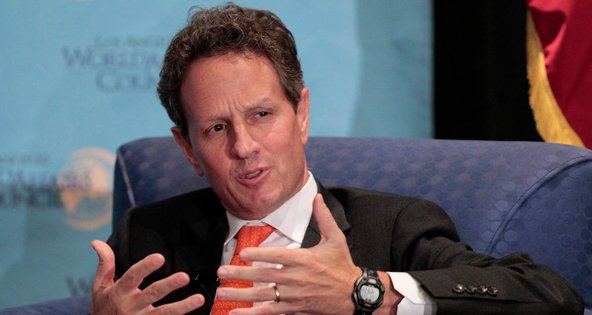
Simon Johnson, former chief economist of the International Monetary Fund, is the Ronald A. Kurtz Professor of Entrepreneurship at the M.I.T. Sloan School of Management and co-author of “White House Burning: The Founding Fathers, Our National Debt, and Why It Matters to You.”
The race is on to determine who will succeed Ben Bernanke as chairman of the Board of Governors of the Federal Reserve System. Mr. Bernanke’s term expires at the end of January 2014 and, while he might still decide he wishes to stay on, indications from the White House increasingly suggest that a change will be made — most likely with a preliminary decision in the next few months.
Today’s Economist
Perspectives from expert contributors.
The leading candidates are Janet Yellen, current vice chairwoman of the Fed; Timothy Geithner, former Treasury secretary and former president of the Federal Reserve Bank of New York; and Lawrence Summers, former Treasury secretary (under President Clinton) and former head of the National Economic Council (under President Obama).
None of these candidates has made or is likely to make a clear statement about the critical issue for the next decade – how the Federal Reserve should view the financial sector, particularly the various potential causes of systemic risk. This is unfortunate, because the role of the central bank has changed considerably in recent decades, and how to deal with global megabanks will be central to the macroeconomic policy agenda going forward.
In the 1960s and 1970s, the mounting threat to the economy was inflation. At the end of the 1970s, the newly appointed Fed chairman, Paul A. Volcker, and his colleagues decided to bring down inflation through tight monetary policy. This was considered highly contentious at the time, but looking back, it seems sensible.
Inflation is a regressive tax – it hits relatively poor people hardest, in part because they lack access to investments that are good hedges against inflation (like real estate and some kinds of equity). It also distorts all kinds of economic activity and makes it hard to plan for the future. Bringing down inflation was costly – higher interest rates caused a recession, with many jobs lost. But the result was a long period of relatively low inflation.
Through at least the end of the 1960s, people at the top of the Fed thought there was a stable trade-off between inflation and unemployment, so policy makers could lower unemployment by allowing inflation to creep higher. That turned out to be illusory.
Not many people argue in favor of high inflation today.
At an event in his honor last week, Mr. Volcker was interviewed by Donald Kohn (a former vice chairman of the Fed; the two of them and I belong to the Federal Deposit Insurance Corporation’s Systemic Resolution Advisory Committee) and emphasized the way in which the policy consensus had shifted by the late 1970s. (I recommend watching the video of this interview, which should be available in a few days on the event Web site.) Mr. Volcker was characteristically modest – and also typically perceptive. When everyone on Main Street sees a problem every day, this helps concentrate the minds of people in power.
The issue today is not control over inflation. There is no sign yet that the crisis of 2008 and resulting easy monetary policy has pushed up inflation, in part because people’s expectations regarding future inflation remain remarkably low and stable.
But the post-Volcker environment of low inflation and low interest rates ushered in a period of hyper-sized finance, both in terms of financial-sector growth relative to the economy and the size of our largest financial institutions. The problems associated now with too-big-to-fail banks, broadly defined, are in part an unintended consequence of successful monetary policy in the 1980s and ’90s. Of course, financial deregulation also played a significant reinforcing role.
More than three years ago, Mr. Volcker himself proposed one of our more significant efforts at re-regulation — what is now known as the Volcker Rule, which is designed to take some very high-risk activities out of financial institutions that are central to the functioning of the economy. On Wednesday, Mr. Volcker referred to the lack of progress in putting his eponymous rule into action as a disgrace.
The problem is that the economic rise of very big banks – the only financial institutions that would be adversely affected by the Volcker Rule, which would limit their “proprietary trading” – also greatly increased their political power. The Volcker Rule was enshrined in the Dodd-Frank financial reform legislation, but our regulators are a fragmented lot, and in the details of rule-writing, the banks have played regulator vs. regulator with great skill.
More broadly, the new head of the Fed needs to be able and willing to confront the financial sector before threats become too large. Inflation was very much in everyone’s faces in the late 1970s. Inflation is often referred to as a hidden tax, but it’s relatively transparent compared with what happens with the buildup on financial sector risk.
In the boom, people working at megabanks receive very high levels of compensation. In a huge financial crash, there are bailouts – various forms of downside protection – for those people and their creditors. Everyone else has to confront a deep and nasty recession, or worse. This is even more regressive than higher inflation, but it is also less obvious than the falling purchasing power of what is in your wallet and your checking account (i.e., the result of inflation).
Richard Fisher, president of the Federal Reserve Bank of Dallas, has made clear his skepticism of our current financial system – he and Harvey Rosenblum have also made very sensible reform proposals. He would be the ideal candidate to become next Fed chair. Unfortunately, the political power of megabanks means Mr. Fisher is unlikely to be called upon. (In a debate sponsored recently by The Economist, I supported Mr. Fisher’s views and carried the readers’ vote, 82 percent to 18 percent. I doubt that this outcome will sway even the editorial policy of that magazine.)
Eventually, we will need Mr. Fisher or someone with similar views, and a president willing to nominate such a person. Before we get there, however, it seems unavoidable that another destructive credit cycle will ensue.
Article source: http://economix.blogs.nytimes.com/2013/05/30/choosing-the-next-head-of-the-federal-reserve/?partner=rss&emc=rss




